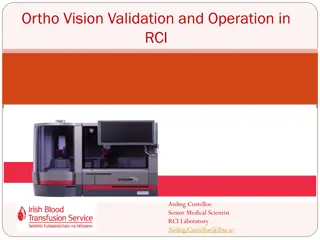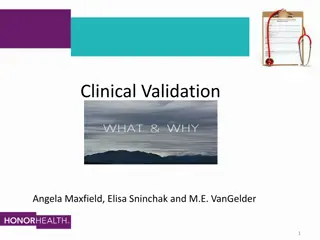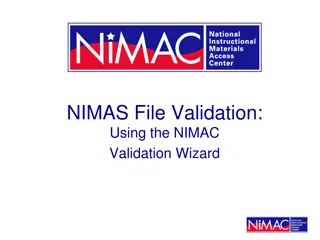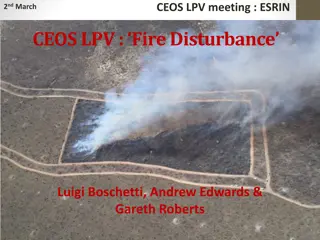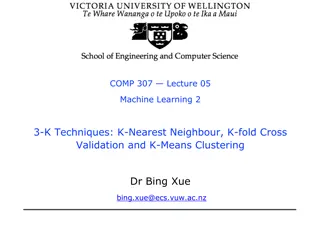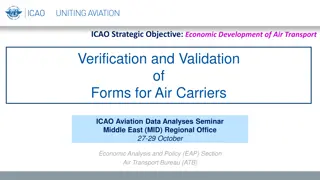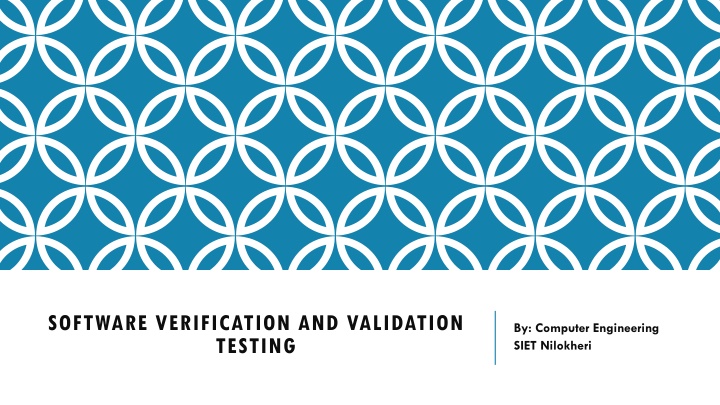
Importance of Software Evolution for Effective Development
Understand the concept of software engineering, software evolution process, and the necessity of software evolution for continuous improvement and adaptation to changing requirements. Software evolution involves developing software initially and updating it over time to meet user needs effectively.
Download Presentation

Please find below an Image/Link to download the presentation.
The content on the website is provided AS IS for your information and personal use only. It may not be sold, licensed, or shared on other websites without obtaining consent from the author. If you encounter any issues during the download, it is possible that the publisher has removed the file from their server.
You are allowed to download the files provided on this website for personal or commercial use, subject to the condition that they are used lawfully. All files are the property of their respective owners.
The content on the website is provided AS IS for your information and personal use only. It may not be sold, licensed, or shared on other websites without obtaining consent from the author.
E N D
Presentation Transcript
SOFTWARE VERIFICATION AND VALIDATION TESTING By: Computer Engineering SIET Nilokheri
CONCEPT OF SOFTWARE ENGINEERING The term software engineering is the product of two words, software, and engineering. The software is a collection of integrated programs. Software subsists of carefully-organized instructions and code written by developers on any of various particular computer languages. Computer programs and related documentation such as requirements, design models and user manuals. Engineering is the application of scientific and practical knowledge to invent, design, build, maintain, and improve frameworks, processes, etc. Software Engineering is an engineering branch related to the evolution of software product using well-defined scientific principles, techniques, and procedures. The result of software engineering is an effective and reliable software product.
SOFTWARE EVOLUTION The process of developing a software product using software engineering principles and methods is referred to as software evolution. This includes the initial development of software and its maintenance and updates, till desired software product is developed, which satisfies the expected requirements. Evolution starts from the requirement gathering process. After which developers create a prototype of the intended software and show it to the users to get their feedback at the early stage of software product development. The users suggest changes, on which several consecutive updates and maintenance keep on changing too. This process changes to the original software, till the desired software is accomplished. Even after the user has desired software in hand, the advancing technology and the changing requirements force the software product to change accordingly. Re-creating software from scratch and to go one-on-one with requirement is not feasible. The only feasible and economical solution is to update the existing software so that it matches the latest requirements
SOFTWARE EVOLUTION You may also defined: Software Evolution is a term which refers to the process of developing software initially, then timely updating it for various reasons, i.e., to add new features or to remove obsolete functionalities etc. The evolution process includes fundamental activities of change analysis, release planning, system implementation and releasing a system to customers. The cost and impact of these changes are accessed to see how much system is affected by the change and how much it might cost to implement the change. If the proposed changes are accepted, a new release of the software system is planned. During release planning, all the proposed changes (fault repair, adaptation, and new functionality) are considered. A design is then made on which changes to implement in the next version of the system. The process of change implementation is an iteration of the development process where the revisions to the system are designed, implemented and tested.
THE NECESSITY OF SOFTWARE EVOLUTION: Software evaluation is necessary just because of the following reasons: Change in Requirement With Time: With the passes of time, the organization s needs and modus Operandi of working could substantially be changed so in this frequently changing time the tools(software) that they are using need to change for maximizing the performance. Environment Change: As the working environment changes the things(tools) that enable us to work in that environment also changes proportionally same happens in the software world as the working environment changes then, the organizations need reintroduction of old software with updated features and functionality to adapt the new environment. Errors and Bugs: As the age of the deployed software within an organization increases their preciseness or impeccability decrease and the efficiency to bear the increasing complexity workload also continually degrades. So, in that case, it becomes necessary to avoid use of obsolete and aged software. All such obsolete Software need to undergo the evolution process in order to become robust as per the workload complexity of the current environment.
CONT Security Risks: Using outdated software within an organization may lead you to at the verge of various software-based cyberattacks and could expose your confidential data illegally associated with the software that is in use. So, it becomes necessary to avoid such security breaches through regular assessment of the security patches/modules are used within the software. If the software isn t robust enough to bear the current occurring Cyber attacks so it must be changed (updated). For Having New Functionality and Features: In order to increase the performance and fast data processing and other functionalities, an organization need to continuously evolute the software throughout its life cycle so that stakeholders & clients of the product could work efficiently.
SOFTWARE EVOLUTION LAWS Lehman has given laws for software evolution. He divided the software into three different categories: S-type (Static-type) - This is a software, which works strictly according to defined specifications and solutions. The solution and the method to achieve it, both are immediately understood before coding. The s- type software is least subjected to changes hence this is the simplest of all. For example, calculator program for mathematical computation. P-type (Practical-type) - This is a software with a collection of procedures. This is defined by exactly what procedures can do. In this software, the specifications can be described but the solution is not obvious instantly. For example, gaming software. E-type (Embedded-type) - This software works closely as the requirement of real-world environment. This software has a high degree of evolution as there are various changes in laws, taxes etc. in the real world situations. For example, Online trading software.
E-TYPE SOFTWARE EVOLUTION Lehman has given eight laws for E-Type software evolution - Continuing change - An E-type software system must continue to adapt to the real world changes, else it becomes progressively less useful. Increasing complexity - As an E-type software system evolves, its complexity tends to increase unless work is done to maintain or reduce it. Conservation of familiarity - The familiarity with the software or the knowledge about how it was developed, why was it developed in that particular manner etc. must be retained at any cost, to implement the changes in the system. Continuing growth- In order for an E-type system intended to resolve some business problem, its size of implementing the changes grows according to the lifestyle changes of the business. Reducing quality - An E-type software system declines in quality unless rigorously maintained and adapted to a changing operational environment.
CONT Feedback systems- The E-type software systems constitute multi-loop, multi-level feedback systems and must be treated as such to be successfully modified or improved. Self-regulation - E-type system evolution processes are self-regulating with the distribution of product and process measures close to normal. Organizational stability - The average effective global activity rate in an evolving E-type system is invariant over the lifetime of the product.
SOFTWARE DEVELOPMENT LIFE CYCLE (SDLC) A software life cycle model (also termed process model) is a pictorial and diagrammatic representation of the software life cycle. A life cycle model represents all the methods required to make a software product transit through its life cycle stages. It also captures the structure in which these methods are to be undertaken. In other words, a life cycle model maps the various activities performed on a software product from its inception to retirement. Different life cycle models may plan the necessary development activities to phases in different ways. Thus, no element which life cycle model is followed, the essential activities are contained in all life cycle models though the action may be carried out in distinct orders in different life cycle models. During any life cycle stage, more than one activity may also be carried out.
NEED OF SDLC The development team must determine a suitable life cycle model for a particular plan and then observe to it. Without using an exact life cycle model, the development of a software product would not be in a systematic and disciplined manner. When a team is developing a software product, there must be a clear understanding among team representative about when and what to do. Otherwise, it would point to chaos and project failure. This problem can be defined by using an example. Suppose a software development issue is divided into various parts and the parts are assigned to the team members. From then on, suppose the team representative is allowed the freedom to develop the roles assigned to them in whatever way they like. It is possible that one representative might start writing the code for his part, another might choose to prepare the test documents first, and some other engineer might begin with the design phase of the roles assigned to him. This would be one of the perfect methods for project failure. A software life cycle model describes entry and exit criteria for each phase. A phase can begin only if its stage-entry criteria have been fulfilled. So without a software life cycle model, the entry and exit criteria for a stage cannot be recognized. Without software life cycle models, it becomes tough for software project managers to monitor the progress of the project.
SDLC CYCLE SDLC Cycle represents the process of developing software. SDLC framework includes the following steps:
THE STAGES OF SDLC Stage1: Planning and requirement analysis Requirement Analysis is the most important and necessary stage in SDLC. The senior members of the team perform it with inputs from all the stakeholders and domain experts or SMEs in the industry. Planning for the quality assurance requirements and identifications of the risks associated with the projects is also done at this stage. Business analyst and Project organizer set up a meeting with the client to gather all the data like what the customer wants to build, who will be the end user, what is the objective of the product. Before creating a product, a core understanding or knowledge of the product is very necessary. For Example, A client wants to have an application which concerns money transactions. In this method, the requirement has to be precise like what kind of operations will be done, how it will be done, in which currency it will be done, etc. Once the required function is done, an analysis is complete with auditing the feasibility of the growth of a product. In case of any ambiguity, a signal is set up for further discussion. Once the requirement is understood, the SRS (Software Requirement Specification) document is created. The developers should thoroughly follow this document and also should be reviewed by the customer for future reference.
CONT Stage2: Requirement Analysis and Specification Once the requirement analysis is done, the next stage is to certainly represent and document the software requirements and get them accepted This is accomplished through "SRS"- Software Requirement Specification document which contains all the product requirements to be constructed and developed during the project life cycle. from the project stakeholders. Stage3: Design The next phase is about to bring down all the knowledge of requirements, analysis, and design of the software project. This phase is the product of the last two, like inputs from the customer and requirement gathering. Stage4: Coding In this phase of SDLC, the actual development begins, and the programming is built. The implementation of design begins concerning writing code. Developers have to follow the coding guidelines described by their management and programming tools like compilers, interpreters, debuggers, etc. are used to develop and implement the code.
CONT Stage5: Testing After the code is generated, it is tested against the requirements to make sure that the products are solving the needs addressed and gathered during the requirements stage. During this stage, unit testing, integration testing, system testing, acceptance testing are done. Stage6: Deployment Once the software is certified, and no bugs or errors are stated, then it is deployed. Then based on the assessment, the software may be released as it is or with suggested enhancement in the object segment. After the software is deployed, then its maintenance begins. Stage7: Maintenance Once when the client starts using the developed systems, then the real issues come up and requirements to be solved from time to time. This procedure where the care is taken for the developed product is known as maintenance.
SDLC MODELS Software Development life cycle (SDLC) is a spiritual model used in project management that defines the stages include in an information system development project, from an initial feasibility study to the maintenance of the completed application. There are different software development life cycle models specify and design, which are followed during the software development phase. These models are also called "Software Development Process Models." Each process model follows a series of phase unique to its type to ensure success in the step of software development.
SOFTWARE TESTING Software testing is a process, to evaluate the functionality of a software application with an intent to find whether the developed software met the specified requirements or not and to identify the defects to ensure that the product is defect-free in order to produce a quality product. According to ANSI/IEEE 1059 standard A process of analyzing a software item to detect the differences between existing and required conditions (i.e., defects) and to evaluate the features of the software item. Software Testing = Verification + Validation
TERMINOLOGIES IN SOFTWARE TESTING An error is a mistake made by an engineer often a misunderstanding of a requirement or design specification. A fault is a manifestation of that error in the code what we often call a bug . A failure is an incorrect output/behavior that is caused by executing a fault. The failure may occur immediately (crash!) or much, much later in the execution. Testing attempts to surface failures in our software systems. Debugging attempts to associate failures with faults so they can be removed from the system. If a system passes all of its tests, is it free of all faults? An incident is the symptom associated with a failure that alert the user to occurrence of a failure. A test is the act of exercising software with test cases.
CONT Test case is defined as a group of conditions under which a tester determines whether a software application is working as per the customer's requirements or not. Test case designing includes preconditions, case name, input conditions, and expected result. A test case is a first level action and derived from test scenarios. Software verification is the process by which we determine whether the software built meets the expected requirements without actually executing the code. Software verification is the process of checking that a software achieves its goal without any bugs. It is the process to ensure whether the product that is developed is right or not. It verifies whether the developed product fulfills the requirements that we have. Verification is Static Testing. Software Validation is the process of checking whether the software product is up to the mark or in other words product has high level requirements. It is the process of checking the validation of product i.e. it checks what we are developing is the right product. it is validation of actual and expected product. Validation is the Dynamic Testing.
STEPS OF SOFTWARE TESTING PROCESS These are 11 steps software testing process is an experience based practical approach for solution to test assignment. These are explained as following below. Step-1: Assess Development Plan and Status This initiative may be prerequisite to putting together Verification, Validation, and Testing Plan wont to evaluate implemented software solution. During this step, testers challenge completeness and correctness of event plan. Based on extensiveness and completeness of Project Plan testers can estimate quantity of resources they re going to got to test implemented software solution. Step-2: Develop the Test Plan Forming plan for testing will follow an equivalent pattern as any software planning process. The structure of all plans should be an equivalent, but content will vary supported degree of risk testers perceive as related to software being developed.
CONT Step-3: Test Software Requirements Incomplete, inaccurate, or inconsistent requirements cause most software failures. The inability to get requirement right during requirements gathering phase can also increase cost of implementation significantly. Testers, through verification, must determine that requirements are accurate, complete, and they do not conflict with another. Step-4: Test Software Design This step tests both external and internal design primarily through verification techniques. The testers are concerned that planning will achieve objectives of wants, also because design being effective and efficient on designated hardware. Step-5: Build Phase Testing The method chosen to build software from internal design document will determine type and extensiveness of testers needed. As the construction becomes more automated, less testing are going to be required during this phase. However, if software is made using waterfall process, it s subject to error and will be verified. Experience has shown that it s significantly cheaper to spot defects during development phase, than through dynamic testing during test execution step.
CONT Step-6: Execute and Record Result This involves testing of code during dynamic state. The approach, methods, and tools laid out in test plan are going to be wont to validate that executable code actually meets stated software requirements, and therefore the structural specifications of design. Step-7: Acceptance Test Acceptance testing enables users to gauge applicability and usefulness of software in performing their day-to-day job functions. This tests what user believes software should perform, as against what documented requirements state software should perform. Step-8: Report Test Results Test reporting is continuous process. It may be both oral and written. It is important that defects and concerns be reported to the appropriate parties as early as possible, so that corrections can be made at the lowest possible cost. Step-9: The Software Installation Once test team has confirmed that software is prepared for production use, power to execute that software during production environment should be tested. This tests interface to operating software, related software, and operating procedures.
CONT Step-10: Test Software Changes While this is often shown as Step 10, within context of performing maintenance after software is implemented, concept is additionally applicable to changes throughout implementation process. Whenever requirements changes, test plan must change, and impact of that change on software systems must be tested and evaluate. Step-11: Evaluate Test Effectiveness Testing improvement can best be achieved by evaluating effectiveness of testing at top of every software test assignment. While this assessment is primarily performed by testers, it should involve developers, users of software, and quality assurance professionals if function exists within the IT organization.
TESTING LIFE CYCLE The procedure of software testing is also known as STLC (Software Testing Life Cycle) which includes phases of the testing process. The testing process is executed in a well-planned and systematic manner. All activities are done to improve the quality of the software product.
DIFFERENCE BETWEEN VERIFICATION AND VALIDATION



